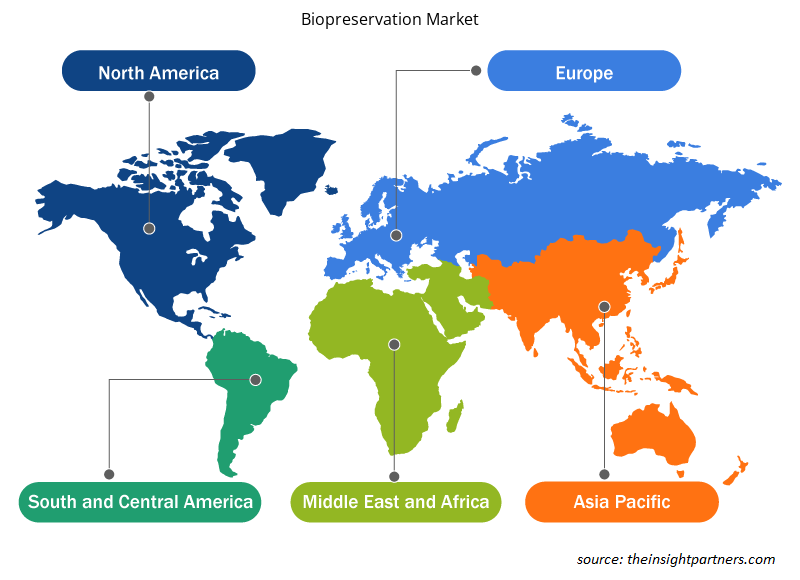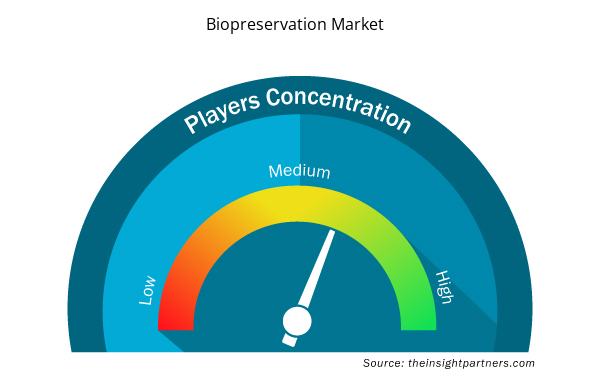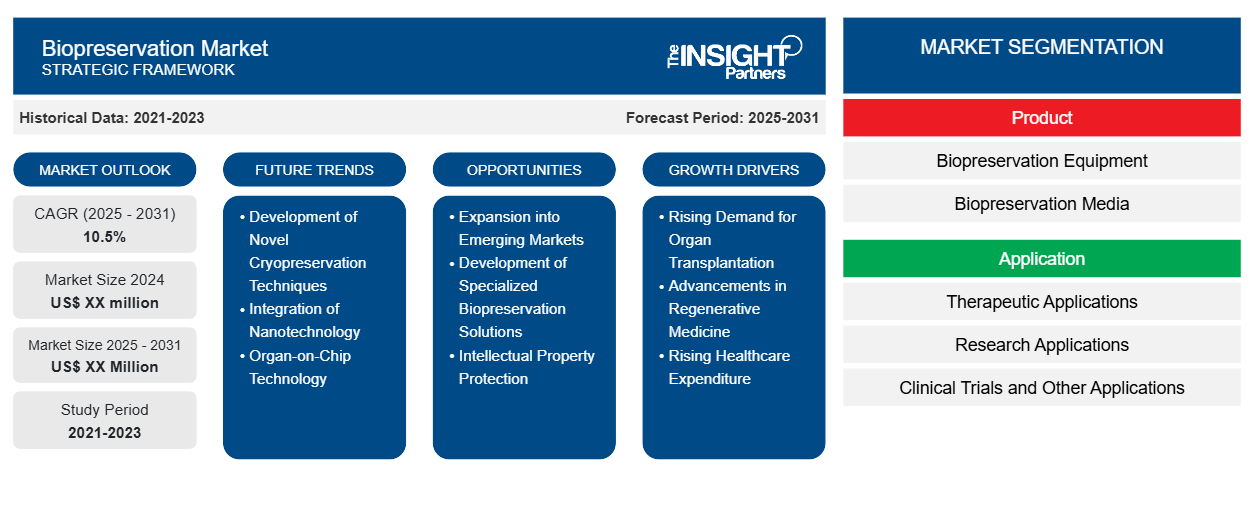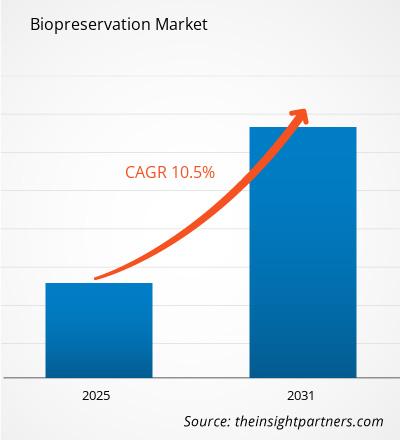Se espera que el mercado de biopreservación registre una CAGR del 10,5 % entre 2023 y 2031, con un tamaño de mercado que se expandirá de US$ XX millones en 2023 a US$ XX millones en 2031.
El informe se divide en cuatro secciones: Producto (Equipo de Biopreservación, Medios de Biopreservación), Aplicación (Aplicaciones Terapéuticas, Aplicaciones de Investigación, Ensayos Clínicos y Otras Aplicaciones), Bioespecímenes (Células Madre, Órganos, Muestras de Tejido Humano, Otros Bioespecímenes) y Usuario Final (Banco de Genes, Hospitales, Biobancos, Otros Usuarios Finales). El análisis global se desglosa a nivel regional y de los principales países. La evaluación del mercado se presenta en dólares estadounidenses para el análisis segmentario anterior.
Propósito del Informe
El informe Biopreservation Market de The Insight Partners tiene como objetivo describir el panorama actual y el crecimiento futuro, los principales factores impulsores, los desafíos y las oportunidades. Esto proporcionará información a diversas partes interesadas del negocio, como:
- Proveedores/fabricantes de tecnología: Para comprender la dinámica cambiante del mercado y conocer las oportunidades potenciales de crecimiento, lo que les permitirá tomar decisiones estratégicas informadas.
- Inversionistas: Realizar un análisis exhaustivo de tendencias sobre la tasa de crecimiento del mercado, las proyecciones financieras del mercado y las oportunidades que existen en toda la cadena de valor.
- Órganos reguladores: Regular las políticas y vigilar las actividades del mercado con el objetivo de minimizar los abusos, preservar la confianza de los inversores y defender la integridad y estabilidad del mercado.
Segmentación del mercado de bioconservación
Producto
- Equipos de bioconservación
- Medios de bioconservación
Solicitud
- Aplicaciones terapéuticas
- Aplicaciones de investigación
- Ensayos clínicos y otras aplicaciones
Bioespecímenes
- Células madre
- Órganos
- Muestras de tejido humano
- Otros bioespecímenes
Usuario final
- Banco de genes
- Hospitales
- Biobancos
- Otros usuarios finales
Usuario final
- Banco de genes
- Hospitales
- Biobancos
- Otros usuarios finales
Personalice este informe según sus necesidades
Obtendrá personalización en cualquier informe, sin cargo, incluidas partes de este informe o análisis a nivel de país, paquete de datos de Excel, así como también grandes ofertas y descuentos para empresas emergentes y universidades.
- Obtenga las principales tendencias clave del mercado de este informe.Esta muestra GRATUITA incluirá análisis de datos, desde tendencias del mercado hasta estimaciones y pronósticos.
Factores impulsores del crecimiento del mercado de la bioconservación
- Creciente demanda de trasplantes de órganos: la creciente necesidad de trasplantes de órganos está impulsando la demanda de técnicas de biopreservación eficaces para mantener la viabilidad de los órganos durante el transporte y el almacenamiento.
- Avances en medicina regenerativa: Los rápidos avances en medicina regenerativa e ingeniería de tejidos están creando una demanda significativa de tecnologías de biopreservación para preservar células, tejidos y órganos para aplicaciones terapéuticas y de investigación.
- Aumento del gasto sanitario: el aumento del gasto sanitario a nivel mundial está impulsando la demanda de tratamientos médicos avanzados que se basan en la biopreservación.
Tendencias futuras del mercado de bioconservación
- Desarrollo de nuevas técnicas de criopreservación: Se espera que el desarrollo de técnicas innovadoras de criopreservación, como la vitrificación, mejore la viabilidad a largo plazo de los materiales biológicos.
- Integración de la nanotecnología: La integración de la nanotecnología en la biopreservación puede mejorar la eficiencia y la eficacia de los procesos de conservación al mejorar la administración de crioprotectores y controlar las velocidades de congelación y descongelación.
- Tecnología de órganos en chips: la biopreservación de organoides y chips de tejidos será crucial para el descubrimiento de fármacos y la medicina personalizada.
Oportunidades de mercado en bioconservación
- Expansión a mercados emergentes: Los mercados emergentes con una creciente infraestructura de atención médica y un gasto creciente en atención médica ofrecen importantes oportunidades de crecimiento para las empresas de biopreservación.
- Desarrollo de soluciones especializadas de biopreservación: el desarrollo de soluciones especializadas de biopreservación para tipos de células y tejidos específicos, como células madre, células inmunes y órganos, puede crear nuevas oportunidades de mercado.
- Protección de la propiedad intelectual: Las estrategias sólidas de protección de la propiedad intelectual pueden salvaguardar las inversiones y garantizar una ventaja competitiva.
Perspectivas regionales del mercado de biopreservación
Los analistas de Insight Partners explicaron en detalle las tendencias y los factores regionales que influyen en el mercado de biopreservación durante el período de pronóstico. Esta sección también analiza los segmentos y la geografía del mercado de biopreservación en América del Norte, Europa, Asia Pacífico, Oriente Medio y África, y América del Sur y Central.

- Obtenga los datos regionales específicos para el mercado de bioconservación
Alcance del informe de mercado sobre bioconservación
| Atributo del informe | Detalles |
|---|---|
| Tamaño del mercado en 2023 | XX millones de dólares estadounidenses |
| Tamaño del mercado en 2031 | US$ XX millones |
| CAGR global (2023 - 2031) | 10,5% |
| Datos históricos | 2021-2022 |
| Período de pronóstico | 2024-2031 |
| Segmentos cubiertos | Por producto
|
| Regiones y países cubiertos | América del norte
|
| Líderes del mercado y perfiles de empresas clave |
|
Densidad de actores del mercado de bioconservación: comprensión de su impacto en la dinámica empresarial
El mercado de la biopreservación está creciendo rápidamente, impulsado por la creciente demanda de los usuarios finales debido a factores como la evolución de las preferencias de los consumidores, los avances tecnológicos y una mayor conciencia de los beneficios del producto. A medida que aumenta la demanda, las empresas amplían sus ofertas, innovan para satisfacer las necesidades de los consumidores y aprovechan las tendencias emergentes, lo que impulsa aún más el crecimiento del mercado.
La densidad de actores del mercado se refiere a la distribución de las empresas o firmas que operan dentro de un mercado o industria en particular. Indica cuántos competidores (actores del mercado) están presentes en un espacio de mercado determinado en relación con su tamaño o valor total de mercado.
Las principales empresas que operan en el mercado de biopreservación son:
- BioLife Solutions Inc.
- Línea de vida científica
- Industrias de gráficos
- Soluciones LabVantage, Inc.
- QIAGEN
Descargo de responsabilidad : Las empresas enumeradas anteriormente no están clasificadas en ningún orden particular.

- Obtenga una descripción general de los principales actores clave del mercado de bioconservación
Puntos de venta clave
- Cobertura integral: el informe cubre de manera integral el análisis de productos, servicios, tipos y usuarios finales del mercado de biopreservación, proporcionando un panorama holístico.
- Análisis de expertos: el informe se compila sobre la base de un profundo conocimiento de expertos y analistas de la industria.
- Información actualizada: El informe asegura relevancia comercial debido a su cobertura de información reciente y tendencias de datos.
- Opciones de personalización: este informe se puede personalizar para satisfacer los requisitos específicos del cliente y adaptarse adecuadamente a las estrategias comerciales.
Por lo tanto, el informe de investigación sobre el mercado de la biopreservación puede ayudar a abrir camino para descifrar y comprender el escenario de la industria y las perspectivas de crecimiento. Si bien puede haber algunas preocupaciones válidas, los beneficios generales de este informe tienden a superar las desventajas.
- Análisis histórico (2 años), año base, pronóstico (7 años) con CAGR
- Análisis PEST y FODA
- Tamaño del mercado Valor/volumen: global, regional, nacional
- Industria y panorama competitivo
- Conjunto de datos de Excel



Report Coverage
Revenue forecast, Company Analysis, Industry landscape, Growth factors, and Trends

Segment Covered
This text is related
to segments covered.

Regional Scope
North America, Europe, Asia Pacific, Middle East & Africa, South & Central America

Country Scope
This text is related
to country scope.
Preguntas frecuentes
Some of the customization options available based on request are additional 3-5 company profiles and country-specific analysis of 3-5 countries of your choice. Customizations are to be requested/discussed before making final order confirmation, as our team would review the same and check the feasibility.
The report can be delivered in PDF/PPT format; we can also share excel dataset based on the request.
The leading players of the Biopreservation Market are: BioLifeSolutions Inc, Lifeline Scientific, Chart Industries, LabVantage Solutions Inc, QIAGEN, BIOGENICS INC, Helmer Scientific, BioCision, Merck KGaA
Biopreservation Market is expected to grow at a CAGR of 10.5% between 2023-2031
The future trends of the Biopreservation Market are: Development of novel cryopreservation techniques and Integration of nanotechnology
The driving factors impacting the Biopreservation Market are: Rising demand for organ transplantation and Advancements in regenerative medicine
Trends and growth analysis reports related to Life Sciences : READ MORE..
1. BioLifeSolutions Inc.
2. Lifeline Scientific
3. Chart Industries
4. LabVantage Solutions, Inc.
5. QIAGEN
6. BIOGENICS, INC.
7. Helmer Scientific.
8. BioCision.
9. Merck KGaA,
10. Sigma-Aldrich Co.
11. AMS Biotechnology
12. OPS Diagnostics
13. Nippon Genetics Europe
14. PHC Holdings Corporation
15. Arctiko
The Insight Partners performs research in 4 major stages: Data Collection & Secondary Research, Primary Research, Data Analysis and Data Triangulation & Final Review.
- Data Collection and Secondary Research:
As a market research and consulting firm operating from a decade, we have published and advised several client across the globe. First step for any study will start with an assessment of currently available data and insights from existing reports. Further, historical and current market information is collected from Investor Presentations, Annual Reports, SEC Filings, etc., and other information related to company’s performance and market positioning are gathered from Paid Databases (Factiva, Hoovers, and Reuters) and various other publications available in public domain.
Several associations trade associates, technical forums, institutes, societies and organization are accessed to gain technical as well as market related insights through their publications such as research papers, blogs and press releases related to the studies are referred to get cues about the market. Further, white papers, journals, magazines, and other news articles published in last 3 years are scrutinized and analyzed to understand the current market trends.
- Primary Research:
The primarily interview analysis comprise of data obtained from industry participants interview and answers to survey questions gathered by in-house primary team.
For primary research, interviews are conducted with industry experts/CEOs/Marketing Managers/VPs/Subject Matter Experts from both demand and supply side to get a 360-degree view of the market. The primary team conducts several interviews based on the complexity of the markets to understand the various market trends and dynamics which makes research more credible and precise.
A typical research interview fulfils the following functions:
- Provides first-hand information on the market size, market trends, growth trends, competitive landscape, and outlook
- Validates and strengthens in-house secondary research findings
- Develops the analysis team’s expertise and market understanding
Primary research involves email interactions and telephone interviews for each market, category, segment, and sub-segment across geographies. The participants who typically take part in such a process include, but are not limited to:
- Industry participants: VPs, business development managers, market intelligence managers and national sales managers
- Outside experts: Valuation experts, research analysts and key opinion leaders specializing in the electronics and semiconductor industry.
Below is the breakup of our primary respondents by company, designation, and region:

Once we receive the confirmation from primary research sources or primary respondents, we finalize the base year market estimation and forecast the data as per the macroeconomic and microeconomic factors assessed during data collection.
- Data Analysis:
Once data is validated through both secondary as well as primary respondents, we finalize the market estimations by hypothesis formulation and factor analysis at regional and country level.
- Macro-Economic Factor Analysis:
We analyse macroeconomic indicators such the gross domestic product (GDP), increase in the demand for goods and services across industries, technological advancement, regional economic growth, governmental policies, the influence of COVID-19, PEST analysis, and other aspects. This analysis aids in setting benchmarks for various nations/regions and approximating market splits. Additionally, the general trend of the aforementioned components aid in determining the market's development possibilities.
- Country Level Data:
Various factors that are especially aligned to the country are taken into account to determine the market size for a certain area and country, including the presence of vendors, such as headquarters and offices, the country's GDP, demand patterns, and industry growth. To comprehend the market dynamics for the nation, a number of growth variables, inhibitors, application areas, and current market trends are researched. The aforementioned elements aid in determining the country's overall market's growth potential.
- Company Profile:
The “Table of Contents” is formulated by listing and analyzing more than 25 - 30 companies operating in the market ecosystem across geographies. However, we profile only 10 companies as a standard practice in our syndicate reports. These 10 companies comprise leading, emerging, and regional players. Nonetheless, our analysis is not restricted to the 10 listed companies, we also analyze other companies present in the market to develop a holistic view and understand the prevailing trends. The “Company Profiles” section in the report covers key facts, business description, products & services, financial information, SWOT analysis, and key developments. The financial information presented is extracted from the annual reports and official documents of the publicly listed companies. Upon collecting the information for the sections of respective companies, we verify them via various primary sources and then compile the data in respective company profiles. The company level information helps us in deriving the base number as well as in forecasting the market size.
- Developing Base Number:
Aggregation of sales statistics (2020-2022) and macro-economic factor, and other secondary and primary research insights are utilized to arrive at base number and related market shares for 2022. The data gaps are identified in this step and relevant market data is analyzed, collected from paid primary interviews or databases. On finalizing the base year market size, forecasts are developed on the basis of macro-economic, industry and market growth factors and company level analysis.
- Data Triangulation and Final Review:
The market findings and base year market size calculations are validated from supply as well as demand side. Demand side validations are based on macro-economic factor analysis and benchmarks for respective regions and countries. In case of supply side validations, revenues of major companies are estimated (in case not available) based on industry benchmark, approximate number of employees, product portfolio, and primary interviews revenues are gathered. Further revenue from target product/service segment is assessed to avoid overshooting of market statistics. In case of heavy deviations between supply and demand side values, all thes steps are repeated to achieve synchronization.
We follow an iterative model, wherein we share our research findings with Subject Matter Experts (SME’s) and Key Opinion Leaders (KOLs) until consensus view of the market is not formulated – this model negates any drastic deviation in the opinions of experts. Only validated and universally acceptable research findings are quoted in our reports.
We have important check points that we use to validate our research findings – which we call – data triangulation, where we validate the information, we generate from secondary sources with primary interviews and then we re-validate with our internal data bases and Subject matter experts. This comprehensive model enables us to deliver high quality, reliable data in shortest possible time.


 Obtenga una muestra gratuita de este informe
Obtenga una muestra gratuita de este informe